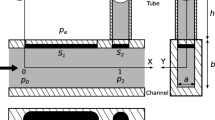Abstract
The basic concepts concerning the mechanism of removal of large amounts of organic liquids from capillary-porous materials in treating the materials with superheated steam are formulated. It is hypothesized that regardless of the level of thermodynamic affinity of the distilled solvent for the skeleton of the porous material, removal of liquid physically-mechanically bound, and not adsorption or osmotically bound with the material is limiting for the process as a whole.
Similar content being viewed by others
REFERENCES
K. V. Pochivalov, Physicochemical Principles of Extraction of a Polymer Component from a Porous Viscoelastic Polymer Material, Doctoral Dissertation, Institute of Chemistry of Solutions, Russian Academy of Sciences, Ivanovo (2002).
L. V. Matveeva, Kozhev.-Obuvn. Prom-st’, No. 1, 49–51 (1969).
B. S. Sazhin, Principles of Drying Technology [in Russian], Khimiya, Moscow (1984).
O. A. Bunin and Yu. A. Malkov, Machines for Drying and Heat Treatment of Fabrics [in Russian], Mashinostroenie, Moscow (1971).
B. N. Mel’nikov, M. N. Kirillova, and A. P. Moryganov, Current State and Prospects for the Development of Textile Dyeing Technology [in Russian], Legkaya i Pishchev. Prom-st’, Moscow (1983).
Yu. A. Mikhailov, Drying with Superheated Steam [in Russian], Energiya, Moscow (1967).
V. I. Konovalov, M. E. Ul’yanov, and V. N. Sokolov, Zh. Prikl. Khim., 48, No.7, 1505–1510 (1975).
V. I. Konovalov, P. G. Romankov, and V. N. Sokolog, Tear. Osnovy Khim. Tekhnol., 9, No.4, 501–510 (1975).
A. V. Lykov, Drying Theory [in Russian], Gosenergoizdat, Moscow-Leningrad (1950).
S. A. Bagaturov, Principles of the Theory and Calculation of Distillation and Fractional Distillation [in Russian], Khimiya, Moscow (1974).
A. G. Kasatkin, Fundamental Processes and Equipment in Chemical Engineering [in Russian], Khimiya, Moscow (1971).
G. K. Filonenko, Kinetics of Drying [in Russian], Oborongiz, Moscow-Leningrad (1939).
N. B. Vargaftik, Handbook of Thermophysical Properties of Gases and Liquids [in Russian], Nauka, Moscow (1972).
A. V. Lykov, Heat and Mass Exchange in Drying Processes [in Russian], Gosenergoizdat, Moscow (1956).
A. V. Lykov and Yu. A. Mikhailov, Theory of Heat and Mass Transfer [in Russian], Gosenergoizdat, Moscow-Leningrad (1963).
S. P. Rudobatshta, Mass Transfer in Systems with a Solid Phase [in Russian], Khimiya, Moscow (1980).
V. F. Frolov, Modeling of Drying of Disperse Materials [in Russian], Khimiya, Leningrad (1987).
Author information
Authors and Affiliations
Additional information
Translated from Khimicheskie Volokna, No. 6, pp. 41–45, November–December, 2004.
Rights and permissions
About this article
Cite this article
Pochivalov, K.V., Mizerovskii, L.N. Theoretical and technological aspects of removal of large amounts of organic liquids from capillary-porous bodies. 1. Mechanism of the process. Fibre Chem 36, 442–446 (2004). https://doi.org/10.1007/s10692-005-0034-4
Issue Date:
DOI: https://doi.org/10.1007/s10692-005-0034-4



